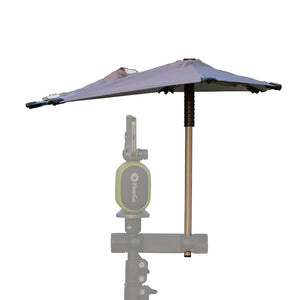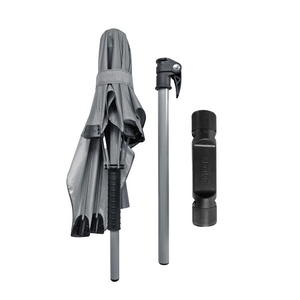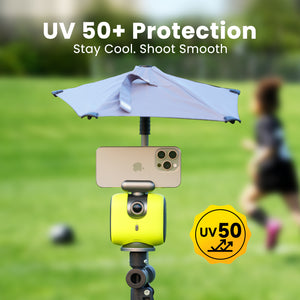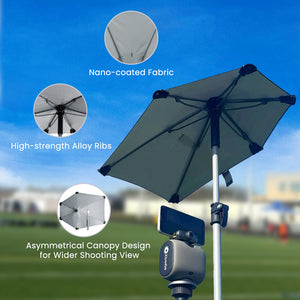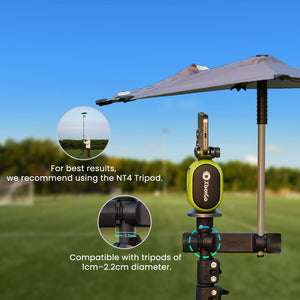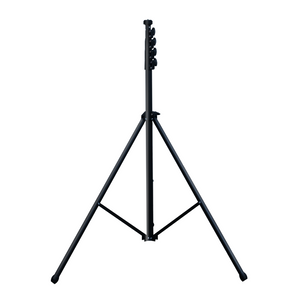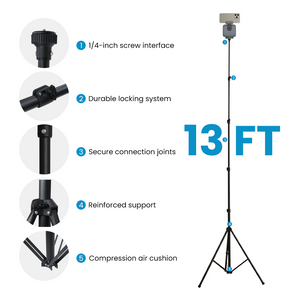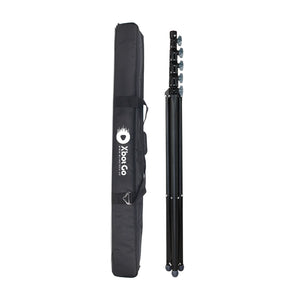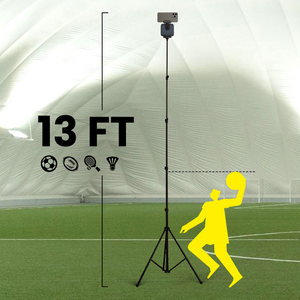XbotGo Chameleon AI Sports Camera
How Long is a Hockey Game? The Complete Guide
Hockey's lightning-fast action and bone-crushing hits make it one of the most thrilling sports to watch—but if you're planning to attend a game or schedule your viewing time, you're probably wondering exactly how long you'll be invested. Here's the surprising truth: while the official game clock shows 60 minutes, you'll actually be watching for 2.5 to 3 hours. TV stations budget 2 hours and 45 minutes for NHL broadcasts, and there's a good reason why that extra time matters for every hockey fan.
Whether you're catching your first NHL game, watching your kid's youth hockey match, or planning a college hockey viewing party, this guide breaks down exactly what to expect—and how to plan accordingly.
The Reality vs. The Clock
Official vs Real Time
A standard hockey game consists of three 20-minute periods, totaling 60 minutes of official playing time. Simple math, right? Not quite.
In reality, those 60 minutes stretch into something much longer. Each period typically runs 35-40 minutes in real time due to stoppages for penalties, goals, icing calls, and puck-out-of-play situations. The game clock stops every time the referee blows the whistle, which happens far more often than newcomers expect.
Between periods, you'll experience two intermissions lasting 15-20 minutes each (17 minutes is standard for NHL games). These breaks allow for ice resurfacing, player recovery, and yes—those commercial breaks that keep the leagues financially healthy.
Why Games Take Longer
Several factors transform that neat 60-minute package into a full evening's entertainment:
Stoppages in Play: Every whistle stops the clock. Whether it's a penalty, an offside call, or the puck sailing into the stands, these interruptions add significant time. During power plays, when one team has more players on the ice due to opponent penalties, the game often sees more stoppages as teams adjust strategies.
Commercial Breaks: NHL games include mandated TV timeouts—three per period during regular season games. These occur at the first stoppage after the 14:00, 10:00, and 6:00 marks of each period, adding roughly 2 minutes per timeout.
Video Reviews: Modern hockey includes video review for goals, offsides, and other crucial calls. While these ensure fairness, they can add several minutes to game time.
Injuries and Equipment Issues: When players get hurt or equipment malfunctions occur, the clock stops while issues are resolved. These unexpected delays can range from 30 seconds to several minutes.
The "Hour Per Period" Rule
Experienced hockey fans swear by a simple planning strategy: allocate one hour per period. This rule of thumb accounts for:
- 20 minutes of game time
- 15-20 minutes of stoppages and interruptions
- 17-20 minutes for the following intermission
This mental math helps you accurately predict when games will end. For a 7:00 PM puck drop, expect to be heading home around 9:30-10:00 PM.
Duration by Hockey Level
NHL Professional Games
NHL games follow the most standardized format, typically lasting 2.5 to 3 hours from puck drop to final buzzer. Here's the breakdown:
- Regulation time: 60 minutes (3×20 minute periods)
- Intermissions: Two 17-minute breaks
- Typical total time: 2 hours 30 minutes to 2 hours 45 minutes
If the game goes to overtime, add another 10-15 minutes for the 5-minute sudden-death period and potential shootout. Playoff games can stretch much longer since they continue with 20-minute sudden-death periods until someone scores—no shootouts allowed.
College Hockey Duration
College hockey mirrors the NHL structure but often runs slightly shorter:
- Game time: Same 60-minute format
- Intermissions: Usually 15 minutes (shorter than NHL)
- Commercial breaks: Fewer and shorter than professional games
- Typical total: 2 to 2.5 hours
The atmosphere might be just as intense, but with less commercial interruption, college games tend to move more quickly.
Youth Hockey Variations
Youth hockey duration varies dramatically by age group, as discovered through extensive community research:
Mites (5-6 years):
- 30 minutes of running time
- Buzzer every 3 minutes for line changes
- Total time: 45-60 minutes
Squirts (9-10 years):
- Three 12-minute periods
- Running time or stop time depending on league
- Total time: 50-70 minutes
Peewees (11-12 years):
- Three 15-minute stop-time periods
- Total time: 1.5 hours
Bantams and Midgets (13-18 years):
- Full three 20-minute stop-time periods
- Total time: 2-2.5 hours
This progression helps young players build endurance while keeping games age-appropriate.
International and Field Hockey
International ice hockey generally follows NHL timing standards, but field hockey tells a different story:
- Ice hockey internationally: 60 minutes (3×20 minute periods)
- Field hockey: Recently changed from 70 minutes (2×35 minute halves) to 60 minutes (4×15 minute quarters)
- Olympic hockey: Follows international ice hockey standards
These variations reflect different sporting traditions and broadcasting needs globally.
Factors That Extend Game Time
Overtime and Shootouts
When regulation time ends in a tie, the game enters overtime—but the format depends on the situation:
Regular Season Overtime:
- 5-minute sudden-death period (3-on-3 format)
- If still tied, proceeds to shootout
- Total added time: 10-20 minutes
Playoff Overtime:
- 20-minute sudden-death periods (5-on-5 format)
- Continues until someone scores
- Can add hours to game time
The longest NHL game in modern history saw the Philadelphia Flyers and Pittsburgh Penguins battle through five overtime periods in 2000—that's 92 additional minutes of hockey after regulation!
Game Flow Elements
Several in-game factors significantly impact duration:
Penalties: Minor penalties (2 minutes) and major penalties (5 minutes) create power play situations. During these times, play often stops more frequently as teams adjust. A game with numerous penalties can easily add 15-20 minutes to total time.
Fights: While less common today, fights stop play completely. The altercation, referee consultation, and penalty assessment can add 5-10 minutes per incident.
Injuries: Player injuries require immediate attention. Serious injuries might add 10+ minutes while medical staff ensures player safety.
Equipment Issues: Broken sticks, damaged boards, or goalie equipment problems all stop the clock. While individual incidents are brief, they accumulate throughout a game.
Broadcasting Impact
Television dramatically influences game duration through:
- Scheduled commercial breaks: Three per period at predetermined times
- Extended intermissions: TV intermissions run 17-20 minutes versus 15 minutes for non-televised games
- Pre-game ceremonies: National anthems, special recognitions, and player introductions
- Post-whistle delays: Broadcasters sometimes need extra seconds to complete replay segments
These broadcasting requirements add approximately 20-30 minutes to the live game experience compared to non-televised matches.
Planning Your Hockey Experience
Attendance Planning
Arriving at the right time enhances your game experience. Season ticket holders recommend:
Arrival Time: Get to the arena 30-45 minutes before scheduled puck drop. This allows time for:
- Parking and security
- Finding your seats
- Watching warmups (highly recommended for first-timers)
- Grabbing concessions without missing game action
Actual Puck Drop: Despite published start times, puck drop typically occurs 10-15 minutes later. A 7:00 PM "start time" usually means a 7:10-7:15 PM puck drop after announcements and the national anthem.
Viewing Schedule Management
For TV viewing or streaming, implement these buffer strategies:
- Regular season games: Block out 3 hours
- Playoff games: Reserve 3.5+ hours (overtime is common)
- Recording games: Add 30-60 minutes to standard recording time
Many fans use the "one hour per period" rule when planning around games. This mental model rarely fails.
Historical and Modern Context
How Game Duration Has Evolved
Hockey game duration hasn't always been standardized. Key milestones include:
Pre-1910: Games consisted of two 30-minute halves
1910-1927: Three 20-minute periods became standard
1942-1983: No overtime in regular season (games could end in ties)
1983-present: 5-minute overtime added to regular season
2005-present: Shootout implemented after overtime
2015-present: 3-on-3 overtime format introduced
These changes reflect the sport's evolution toward more exciting finishes while maintaining reasonable time constraints for broadcasters and fans.
Longest Games in History
Hockey's marathon matches showcase the sport's incredible endurance demands:
- Detroit Red Wings vs. Montreal Maroons (1936): 176 minutes, 30 seconds—nearly three full games worth of hockey
- Maple Leafs vs. Bruins (1933): 164 minutes, 46 seconds
- Philadelphia Flyers vs. Pittsburgh Penguins (2000): 152 minutes, 1 second—the longest modern game
These epic battles remind us that while we can estimate game duration, hockey's sudden-death overtime format means anything's possible.
Modern Broadcasting Era
Today's game duration reflects modern broadcasting realities:
- Consistent scheduling: Networks need predictable time slots
- Enhanced analysis: Between-period segments featuring expert commentary
- Digital integration: Social media highlights and real-time statistics
- Global audiences: Scheduling considerations for international viewers
These factors have standardized game presentation while maintaining hockey's unique flow and excitement.
Conclusion
Understanding hockey game duration helps you plan the perfect viewing experience. Remember the key takeaway: while the clock shows 60 minutes, budget 2.5 to 3 hours for your hockey commitment. Use the "hour per period" rule for scheduling, arrive early to soak in the atmosphere, and always add buffer time for those thrilling overtime possibilities.
Whether you're watching future NHL stars in youth leagues, catching college hockey's raw intensity, or experiencing the polished production of professional games, you now have the knowledge to plan accordingly. The next time someone asks, "How long is a hockey game?"—you'll have the complete answer.
XbotGo Chameleon AI Sports Camera
Capture every moment with AI-powered tracking. Perfect for coaches, parents, and athletes who want seamless footage without manual filming.







 Soccer
Soccer Basketball
Basketball Ice Hockey
Ice Hockey Rugby
Rugby










